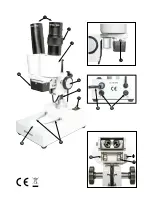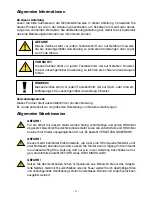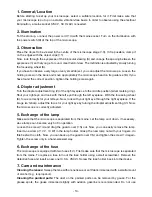
- 10 -
1. General/Location
Before starting to set up your microscope, select a suitable location for it. First make sure that
your microscope is put up on a stable, vibration-free basis. In order to observe using the electrical
illumination, a mains socket (230 V, 50 Hz AC) is needed.
2. Illumination
For the start-up, connect the power cord (13) with the mains socket. Turn on the illumination with
the power switch (9) at the top of the microscope.
3. Observation
Place the object to be viewed in the centre of the microscope stage (10). If it is possible, clamp it
on the edges with the object clips (11).
Now, look through the eyepieces of the binocular viewing (3) and change the spacing between the
eyepieces (1) so that you get a round, clear field of view. The definition is adjusted by slowly turning
the focussing wheel (6).
If you have to observe a very large or very small object, you can adjust the microscope. Loosen the
holding screw on the back and move appropriately the microscope head on its guidance (8). If you
have found the correct position, tighten the holding screw again.
4. Diopter adjustment
Turn the diopter adjustment ring (2) of the right eyepiece to the middle position (silver marking ring).
Shut your right eye and look with the left eye through the left eyepiece. With the focussing wheel
(6), focus correctly for your left eye. Now, look with your right eye through the right eyepiece. If the
image isn’t sharp, adjust the focus for your right eye by turning the diopter adjustment ring (2). Now,
the microscope is correctly adjusted.
5. Exchange of the lamp
Make sure that the microscope is separated from the mains. Let the lamp cool down, if necessary,
since lamps can become very hot in operation.
Loosen the screw (14) and drag the guard cover (15) out. Now, you can easily remove the lamp.
Insert a new lamp (12 V, 10 W) in the lamp holder. Grasp the new lamp not with your fingers, do
this best with a cloth. Now, you can back up the guard cover (15) and tighten the screw (14) again.
Tighten the screw only in a hand-screwed way.
6. Exchange of the fuse
The microscope is equipped with two fuses (12). First make sure that the microscope is separated
from the mains. To replace a fuse turn out the fuse holder using a small screwdriver. Remove the
defective fuse and insert a new one (0.5 A, 250 V). Screw the fuse holder back into the device.
7. Care and maintenance
Cleaning the lenses:
Sweep the lens with a lens tissue or soft fabric immersed with a small amount
of alcohol (e.g. isopropanol).
Cleaning the painted parts:
The dust on the painted parts can be removed by gauze. For the
grease spots, the gauze immersed slightly with aviation gasoline is recommended. Do not use


































